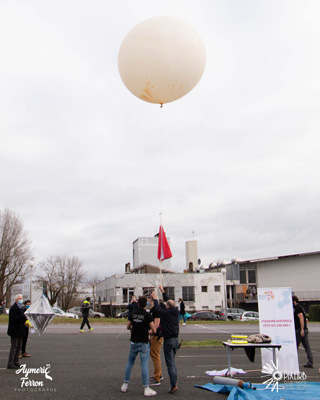聯系我們
與泰克代表實時聊天。 工(gōng)作(zuò)時間:上午 9:00 - 下午 5:00(太平洋标準時間)。
緻電(diàn)我們
工(gōng)作(zuò)時間:上午9:00-下午5:00(太平洋标準時間)
下載
下載手冊、産(chǎn)品技(jì )術資料、軟件等:
反饋
Bordeaux INP
Students in Bordeaux experiment with nanosatellites to explore our solar system

Learn more about the product mentioned in this story here:
The final frontier. The great unknown. There is so much discovery that has yet to happen in our universe, so getting students interested in and excited about space exploration is essential. Fortunately, the Nanolab Academy program, run by France’s National Space Centre (CNES), is doing just that. The program invites students to participate in the development, launch and operation of standardized CubeSats nanosatellites.
Throughout the program students experience all stages of space-related projects from product development and launch to the reception of telemetry and transmission of remote controls and data processing. And in going through each phase, students gain a deeper knowledge of various fields, including mechanics, thermodynamics, avionics, attitude control and energy systems.
Engaging a new generation in space exploration
Students at the Bordeaux INP’s National School of Electronics, Computer Science, Telecommunications, Mathematics and Mechanics (ENSEIRB-MATMECA) participated in the Nanolab Academy program with the support of the Nouvelle-Aquitaine Academic Space Centre, an association of higher education institutions that provides training for civil and military space fields.
During the program, students conducted a series of experiments using the LoRa Internet of Things protocol. The experiments involved sending and receiving signals to and from a stratospheric balloon. The goal was to prove how well the students’ base station could communicate with orbiting nanosatellites that were collecting data and sending it back down to earth. The students would run an experiment to confirm that signals were being received by the nanosatellites, and if the satellites weren’t able to communicate with the base station, students would reconfigure them.
Because much of the work was being done by students who are still developing their expertise in signal analysis, the signals needed to be tested using a spectrum analyzer. However, conventional spectrum analyzers can’t measure signals in real time, something that was essential to the project.
Instruments that can go the distance

Using proprietary DPX technology, the RSA5000B provides a color-graded image, which allows users to see different signals at the same frequency separated by either time or power levels. They can also see how those signals change over time. So if there is an error in communication or a failed signal, students can see exactly when it occurs.
Other spectrum analyzers can’t capture signals in the time domain and aren’t built to catch transient, intermittent, or unexpected signals. That means researchers could miss a blimp in the signal altogether. Tektronix real-time spectrum analyzers, however, have a 100% probability of catching these types of signals.
“Tektronix equipment analyzes the strengths of signals, which helps us determine the distance of the balloon and where it is on its flightpath,” said Anthony Ghiotto, an associate professor at ENSEIRB-MATMECA who is leading the project with Associate Professor Guillaume Ferré. “We can then correlate that information with GPS data to confirm what we are seeing. Other equipment we looked at did not offer this capability.”
By using the RSA5000B and seeing how the signals behaved over time, the team could be confident in the design of the nanosatellites. The team also used the RSA5000B analyzer to ensure their chosen frequency was available, so other signals wouldn’t interfere with their communication, compromising the project.
As the team conducts experiments with the balloon nanosatellites, they plan to document their findings on YouTube and share them with other schools to further advance the field of metrology. And none of this would be possible without the real-time capabilities of the RSA5000B.

